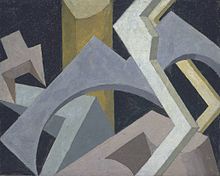Jessica Dismorr
Jessica Dismorr | |
|---|---|
Gravesend, Kent, England | |
| Died | 29 August 1939 (aged 54) London, England |
| Education | Slade School of Fine Art |
| Known for | Abstract painting |
Jessica Stewart Dismorr (3 March 1885 – 29 August 1939) was an English painter and illustrator. Dismorr participated in almost all of the avant-garde groups active in London between 1912 and 1937 and was one of the few English painters of the 1930s to work in a completely abstract manner. She was one of only two women members of the
Early life
Dismorr was born at
Dismorr attended the
Vorticism
Dismorr met

Apart from Dismorr, the only other female member of the Vorticist group was
World War I
During
From 1920 until 1924 she appears to have had no settled home and travelled throughout Europe, spending time in Paris, the Alpes-Maritimes and in both London and Folkestone.[1] She had a nervous breakdown in 1920 and received medical advice not to paint. Lewis suspected that it was her modern style that was causing the doctors concern, and wrote to her that "the best possible distraction for you would be to paint".
Later life
In 1924 Dismorr began a series of water colour paintings of music hall performers, a popular subject at the time.[3] In 1925 her first solo exhibition was held at the Mayor Gallery in London.[6][12] R. H. Wilenski wrote the introduction to the exhibition cataloue.[1] The exhibition included a series of water colours of landscapes painted in France, Italy, Spain, Scotland and England.[3] A Fauve type composition, Pyrenean Town, was reproduced in reviews of the show and also shown at the Seven and Five Society.[3][6] Caring for her ill mother left Dismorr little time to paint and throughout 1926 she mostly showed previously displayed works.
Both her mother and sister Blanche died in 1926 and Dismorr herself was ill during 1927.
She exhibited with Charles Ginner and Barbara Hepworth in the London Group, as well as with Ivon Hitchens and Ben Nicholson in the Seven and Five Society, having joined both groups in 1926.[12] Dismorr showed with the anti-fascist Artists' International Association in the early 1930s and again in 1937.[5][13] Dismorr was one of seven British women artists included in the 1936 Die Olympiade ouder Dictatwar exhibition in Amsterdam which aimed to counter the Nazi condemnation of Modernism and modern art.[13]
Dismorr produced several pointillist self-portraits alongside portraits of her mother and female friends.[3] One of these was of the artist Catherine Dawson Giles, whom Dismorr had known since 1904 when they met in Etaples. The two had also travelled together on painting expeditions in Europe in the 1920s.[1] For several years Dismorr had lived at the Giles family home in London and also had a studio at Giles' cottage at Alfriston in Sussex.[4][6] Throughout her final years, Dismorr continued painting and exhibiting her work, which became completely abstract during the late 1930s. She exhibited with the Association Abstraction-Creation.[2] She contributed her work, "Related Forms" to Axis magazine in 1937 (no 8: 25).[14]
Dismorr died by suicide by hanging in London on 29 August 1939, five days before Britain declared war on Germany.[2]
Later exhibitions and research
A joint exhibition of works by Dismorr and Giles was held in 2000 at the Fine Art Society in London, with a catalogue written by Quentin Stevenson.[3] Pallant House Gallery held an exhibition of the works of Dismorr and her contemporaries in early 2020.[15] The exhibition was curated by the Gallery in partnership with Dr Alicia Foster.[15][5]
Catherine Heathcock's (unpublished) PhD thesis contains a complete catalogue of Dismorr's works. The letters between Dismorr and Lewis are now held at Cornell University.[citation needed]
References
- ^ a b c d e f g h i j k l m Quentin Stevenson (2000). Jessica Dismorr and Catherine Giles. The Fine Art Society PLC.
- ^ ISBN 0-19-861406-3.
- ^ ISBN 1-884964-21-4.
- ^ ISBN 1-85437-311-0.
- ^ a b c d Alicia Foster (16 December 2019). "Jessica Dismorr: The radical pioneer of Vorticism". Art UK. Retrieved 28 May 2020.
- ^ ISBN 9780500021828.
- ISBN 1851491708.
- ^ ISBN 0-7108-1144-6.
- ^ "Landscape". Victoria and Albert Museum. Retrieved 24 April 2018.
- ISBN 978-1854378859.
- ^ "William Roberts, 'The Vorticists at the Restaurant de la Tour Eiffel: Spring, 1915' 1961–2". Tate Gallery. Retrieved 13 September 2016.
- ^ ISBN 1-85149-106-6.
- ^ ISBN 9780993088483.
- ^ AXIS no 8, Winter 1937. "Axis - Monoskop". monoskop.org. Retrieved 13 September 2016.
{{cite web}}: CS1 maint: numeric names: authors list (link) - ^ a b Glover, Michael (28 December 2019). "Jessica Dismorr Is Getting Her Due, 80 Years Too Late". Hyperallergic. Retrieved 2 January 2020.
Further reading
- Richard Cork. "Dismorr, Jessica." Grove Art Online. Oxford Art Online. [1]. Retrieved 11 March 2009
- Richard Cork (1976). Vorticism and Abstract Art in the First Machine Age. University of California Press. (2 vols.) ISBN 0-520-03269-1.
External links
- 8 artworks by or after Jessica Dismorr at the Art UK site
- An example of Dismorr's Vorticist work at the Wayback Machine (archived February 22, 2006)
- Biddy Peppin on the female Vorticists.
- "Poems, from the John Henry Bradley Storrs papers - Poems of Jessica Dismorr". Archives of American Art. Smithsonian Institution. Retrieved 13 September 2016.
- "A little gallery for Jessie Dismorr". Richard Warren. 17 February 2014. Retrieved 13 September 2016.

